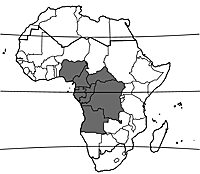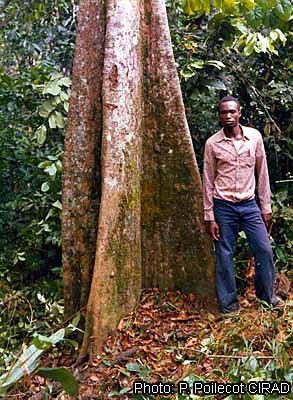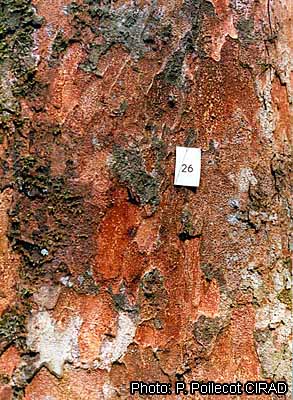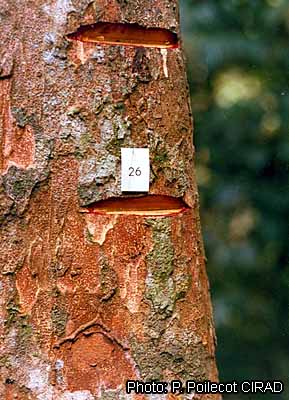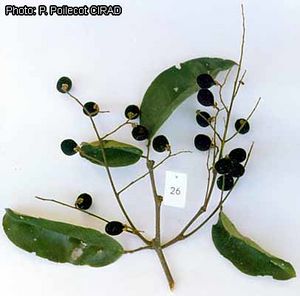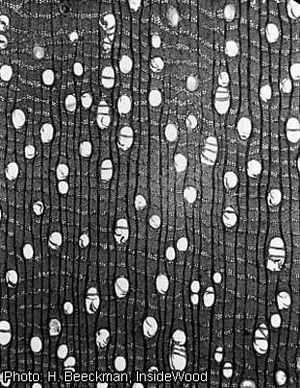Dialium pachyphyllum (PROTA)
Introduction |
Dialium pachyphyllum Harms
- Protologue: Bot. Jahrb. Syst. 53: 468 (1915).
- Family: Caesalpiniaceae (Leguminosae - Caesalpinioideae)
Synonyms
- Dialium macranthum A.Chev. (1916),
- Dialium yambataense Vermoesen (1923).
Origin and geographic distribution
Dialium pachyphyllum occurs from south-eastern Nigeria east to the Central African Republic and south to northern Angola.
Uses
In Gabon the wood, known as ‘omvong’, is used for posts in house building and in DR Congo for turnery. It is suitable for heavy construction including hydraulic works, heavy flooring, joinery, interior trim, mine props, ship building, vehicle bodies, furniture, railway sleepers, ladders, sporting goods, toys, novelties, vats, agricultural implements, tool handles, turnery and sliced veneer. In DR Congo, it is valued for charcoal production.
In Congo ground young leaves with salt are taken to treat cough, whereas bark macerations are administered for the same purpose in Gabon. In DR Congo bark decoctions are administered as enema to treat sterility. Gum resin from the bark is considered poisonous and has been used in DR Congo as ordeal poison and to prepare arrow poison; however, in Congo it is applied to heal wounds.
Properties
The heartwood is brown to pinkish brown, sometimes with darker streaks and markings, and is distinctly demarcated from the yellowish white or pale brown, wide sapwood. The grain is usually straight, sometimes slightly interlocked, texture fine. The wood is resinous. It is heavy, with a density of 890–1060 kg/m³ at 12% moisture content, hard and tough. Drying may cause distortion and splitting, and should be done with care. The rates of shrinkage are high, from green to oven dry 5.3–5.8% radial and 10.4–11.0% tangential. It is recommended to quarter-saw logs for best results. Once dry, the wood is unstable in service. At 12% moisture content, the modulus of rupture is 172–263 N/mm², modulus of elasticity 20, 100–25,200 N/mm², compression parallel to grain 73–116 N/mm², compression perpendicular to grain 4–17 N/mm², shear 10 N/mm², Janka side hardness 14,000 N, Janka end hardness 14,100 N and Chalais-Meudon side hardness 11.4–14.7.
The wood is very difficult to saw due to the presence of silica; saw blades blunt extremely rapidly and often heat up and stain the wood. It is difficult to work with both hand and machine tools, but planes to a good finish with a nice polish without the use of a filler. The wood holds nails and screws well, but pre-boring is required. It glues well, turns well and is suitable for sliced veneer. The wood is durable; it is usually resistant to fungal, dry-wood borer, termite and marine borer attacks. The sapwood is susceptible to Lyctus attack. The heartwood is extremely resistant to impregnation with preservatives. The sawdust may cause irritation to mucous membranes in wood workers.
Description
- Small to medium-sized tree up to 20(–30) m tall; bole branchless for up to 15 m, usually straight and cylindrical or slightly fluted at base, up to 90 cm in diameter, with small to fairly large buttresses; bark surface scaly with small, irregular scales, yellowish brown to reddish brown, inner bark thin, brittle, yellowish white to pinkish, with a reddish, sticky exudate; crown rounded, dense, with sinuous branches; twigs with numerous lenticels, soon glabrous.
- Leaves alternate, imparipinnately compound with 3–5 leaflets; stipules linear, caducous; petiole and rachis together 8–17 cm long; petiolules c. 0.5 cm long; leaflets alternate to nearly opposite, oblong-elliptical, 8–23 cm × 3–8 cm, cuneate to rounded at base, acuminate at apex, leathery, glabrous, pinnately veined with about 10 pairs of lateral veins.
- Inflorescence a terminal or axillary panicle up to 20 cm long, yellowish brown hairy.
- Flowers bisexual, zygomorphic, fragrant; pedicel short; sepals 5, free, triangular, c. 4 mm long, hairy; petal 1, spatulate, c. 4 mm long, yellowish; disk pentagonal, c. 2 mm in diameter, dark brown hairy; stamens 2; ovary superior, ovoid, sessile, hairy, 1-celled, style curved.
- Fruit a globose to obovoid, slightly flattened pod c. 2.5 cm × 1.5 cm, densely dark brown hairy, with greenish white pulp, sepals persistent at base, indehiscent, 1(–2)-seeded.
- Seed flattened ellipsoid, c. 1 cm long, dark brown to black.
Other botanical information
Dialium comprises nearly 30 species and is pantropical. Approximately 15 species occur in mainland tropical Africa and 3 in Madagascar, whereas tropical Asia has about 7 species and tropical America one.
Dialium pachyphyllum is close to Dialium angolense Welw. ex Oliv. and possibly conspecific.
Anatomy
Wood-anatomical description (IAWA hardwood codes):
- Growth rings: 2: growth ring boundaries indistinct or absent.
- Vessels: 5: wood diffuse-porous; 13: simple perforation plates; 22: intervessel pits alternate; 23: shape of alternate pits polygonal; 26: intervessel pits medium (7–10 μm); (27: intervessel pits large (≥ 10 μm)); 30: vessel-ray pits with distinct borders; similar to intervessel pits in size and shape throughout the ray cell; 42: mean tangential diameter of vessel lumina 100–200 μm; 47: 5–20 vessels per square millimetre.
- Tracheids and fibres: 61: fibres with simple to minutely bordered pits; 66: non-septate fibres present; 69: fibres thin- to thick-walled.
- Axial parenchyma: 78: axial parenchyma scanty paratracheal; 86: axial parenchyma in narrow bands or lines up to three cells wide; 92: four (3–4) cells per parenchyma strand; 93: eight (5–8) cells per parenchyma strand.
- Rays: 97: ray width 1–3 cells; 104: all ray cells procumbent; 115: 4–12 rays per mm.
- Storied structure: 118: all rays storied; 120: axial parenchyma and/or vessel elements storied.
- Mineral inclusions: 136: prismatic crystals present; 142: prismatic crystals in chambered axial parenchyma cells; 159: silica bodies present; 161: silica bodies in axial parenchyma cells.
Growth and development
In Gabon trees most commonly flower from November to January, and fruits ripen about 6 months after flowering. The sweetish fruit pulp is eaten by monkeys, which possibly disperse the seeds.
Ecology
Dialium pachyphyllum occurs in dense evergreen rainforest, up to 700 m altitude. It is found on well drained as well as swampy localities.
Management
In forest in Gabon, the average wood volume of Dialium pachyphyllum has been recorded to be 6 m³ per ha. In a transect in Equatorial Guinea, a mean density of 0.6 trees with a bole diameter of more than 70 cm has been found per ha.
Harvesting
In Gabon the minimum bole diameter allowed for harvesting is 70 cm.
Genetic resources
Dialium pachyphyllum has a fairly wide distribution area and seems fairly common in many parts of its range. Although it often occurs scattered in the forest and seems to prefer primary forest, at present there are no indications of threats by genetic erosion.
Prospects
Although Dialium pachyphyllum provides a useful timber that is particularly valued for heavy construction, there is little information available on many aspects. Further research on its growth, development and proper management in natural forest is warranted. Difficulties in sawing and working of the wood hamper exploitation for domestic usage.
Major references
- Aubréville, A., 1970. Légumineuses - Césalpinioidées (Leguminosae - Caesalpinioideae). Flore du Cameroun. Volume 9. Muséum National d’Histoire Naturelle, Paris, France. 339 pp.
- Bolza, E. & Keating, W.G., 1972. African timbers: the properties, uses and characteristics of 700 species. Division of Building Research, CSIRO, Melbourne, Australia. 710 pp.
- Burkill, H.M., 1995. The useful plants of West Tropical Africa. 2nd Edition. Volume 3, Families J–L. Royal Botanic Gardens, Kew, Richmond, United Kingdom. 857 pp.
- de Saint-Aubin, G., 1963. La forêt du Gabon. Publication No 21 du Centre Technique Forestier Tropical, Nogent-sur-Marne, France. 208 pp.
- Neuwinger, H.D., 1996. African ethnobotany: poisons and drugs. Chapman & Hall, London, United Kingdom. 941 pp.
- Rojo, J.P., 1982. Studies in the genus Dialium. PhD thesis, University of Oxford. 282 pp.
- Tailfer, Y., 1989. La forêt dense d’Afrique centrale. Identification pratique des principaux arbres. Tome 2. CTA, Wageningen, Pays-Bas. pp. 465–1271.
- Takahashi, A., 1978. Compilation of data on the mechanical properties of foreign woods (part 3) Africa. Shimane University, Matsue, Japan. 248 pp.
- Vivien, J. & Faure, J.J., 1985. Arbres des forêts denses d’Afrique Centrale. Agence de Coopération Culturelle et Technique, Paris, France. 565 pp.
- Wilczek, R., Léonard, J., Hauman, L., Hoyle, A.C., Steyaert, R., Gilbert, G. & Boutique, R., 1952. Caesalpiniaceae. In: Robyns, W., Staner, P., Demaret, F., Germain, R., Gilbert, G., Hauman, L., Homès, M., Jurion, F., Lebrun, J., Vanden Abeele, M. & Boutique, R. (Editors). Flore du Congo belge et du Ruanda-Urundi. Spermatophytes. Volume 3. Institut National pour l’Étude Agronomique du Congo belge, Brussels, Belgium. pp. 234–554.
Other references
- Allen, O.N. & Allen, E.K., 1981. The Leguminosae: a source book of characteristics, uses and nodulation. MacMillan, London, United Kingdom. 812 pp.
- Aubréville, A., 1968. Légumineuses - Caesalpinioidées (Leguminosae - Caesalpinioideae). Flore du Gabon. Volume 15. Muséum National d’Histoire Naturelle, Paris, France. 362 pp.
- CIRAD Forestry Department, 2009. Eyoum. [Internet] Tropix 6.0. http://tropix.cirad.fr/ africa/ eyoum.pdf. February 2012.
- Fouarge, J., Quoilin, J. & Roosen, P., 1970. Essais physiques, mécaniques et de durabilité de bois de la République Démocratique du Congo. Série technique No 76. Institut National pour l’Etude Agronomique du Congo (INEAC), Brussels, Belgium. 40 pp.
- Keay, R.W.J., 1989. Trees of Nigeria. A revised version of Nigerian trees (1960, 1964) by Keay, R.W.J., Onochie, C.F.A. & Stanfield, D.P. Clarendon Press, Oxford, United Kingdom. 476 pp.
- Konda ku Mbuta, Kabakura Mwima, Mbembe Bitengeli, Itufa Y'Okolo, Mahuku Kavuna, Mafuta Mandanga, Mpoyi Kalambayi, Ndemankeni Izamajole, Kadima Kazembe, Kelela Booto, Ngiuvu Vasaki, Bongombola Mwabonsika & Dumu Lody, 2010. Plantes médicinales de traditions. Province de l'Equateur - R.D. Congo. Institut de Recherche en Sciences de la Santé (I.R.S.S.), Kinshasa, D.R.Congo. 418 pp.
- Neuwinger, H.D., 2000. African traditional medicine: a dictionary of plant use and applications. Medpharm Scientific, Stuttgart, Germany. 589 pp.
- Nkeoua, G. & Boundzanga, G.C., 1999. Données sur les produits forestiers non ligneux en République du Congo. FAO, Brazzaville, Congo. 125 pp.
- Pauwels, L., 1993. Nzayilu N’ti: guide des arbres et arbustes de la région de Kinshasa Brazzaville. Scripta Botanica Belgica. Volume 4. Jardin botanique national de Belgique, Meise, Belgium. 495 pp.
- Raponda-Walker, A. & Sillans, R., 1961. Les plantes utiles du Gabon. Paul Lechevalier, Paris, France. 614 pp.
- Sallenave, P., 1964. Propriétés physiques et mécaniques des bois tropicaux. Premier supplément. Centre Technique Forestier Tropical, Nogent-sur-Marne, France. 79 pp.
- van Reeth, L. & Ngomo, D., 1997. Biodiversité végétale des ligneux sur le transect de Ncumekie dans le Parc de Monte Alen (Guinée Equatoriale). Groupement Agreco-CTFT, projet ECOFAC composante Guinée. 92 pp.
- Wilks, C. & Issembé, Y., 2000. Les arbres de la Guinée Equatoriale: Guide pratique d’identification: région continentale. Projet CUREF, Bata, Guinée Equatoriale. 546 pp.
Sources of illustration
- Aubréville, A., 1970. Légumineuses - Césalpinioidées (Leguminosae - Caesalpinioideae). Flore du Cameroun. Volume 9. Muséum National d’Histoire Naturelle, Paris, France. 339 pp.
- Wilks, C. & Issembé, Y., 2000. Les arbres de la Guinée Equatoriale: Guide pratique d’identification: région continentale. Projet CUREF, Bata, Guinée Equatoriale. 546 pp.
Author(s)
- J.K. Mensah, Forestry Research Institute of Ghana (FORIG), University P.O. Box 63, KNUST, Kumasi, Ghana
Correct citation of this article
Mensah, J.K., 2012. Dialium pachyphyllum Harms. [Internet] Record from PROTA4U. Lemmens, R.H.M.J., Louppe, D. & Oteng-Amoako, A.A. (Editors). PROTA (Plant Resources of Tropical Africa / Ressources végétales de l’Afrique tropicale), Wageningen, Netherlands.
Accessed 31 May 2025.
- See the Prota4U database.

